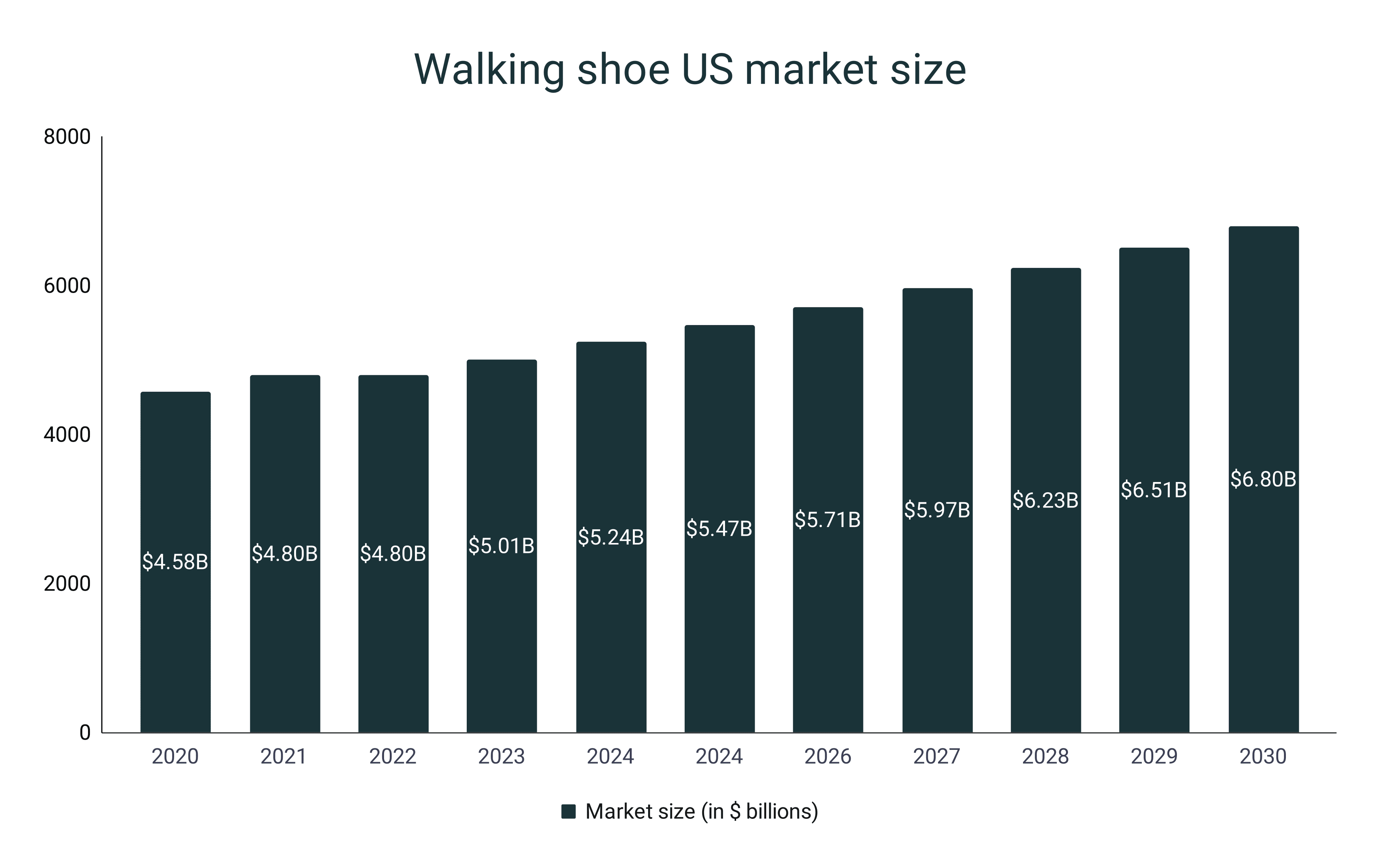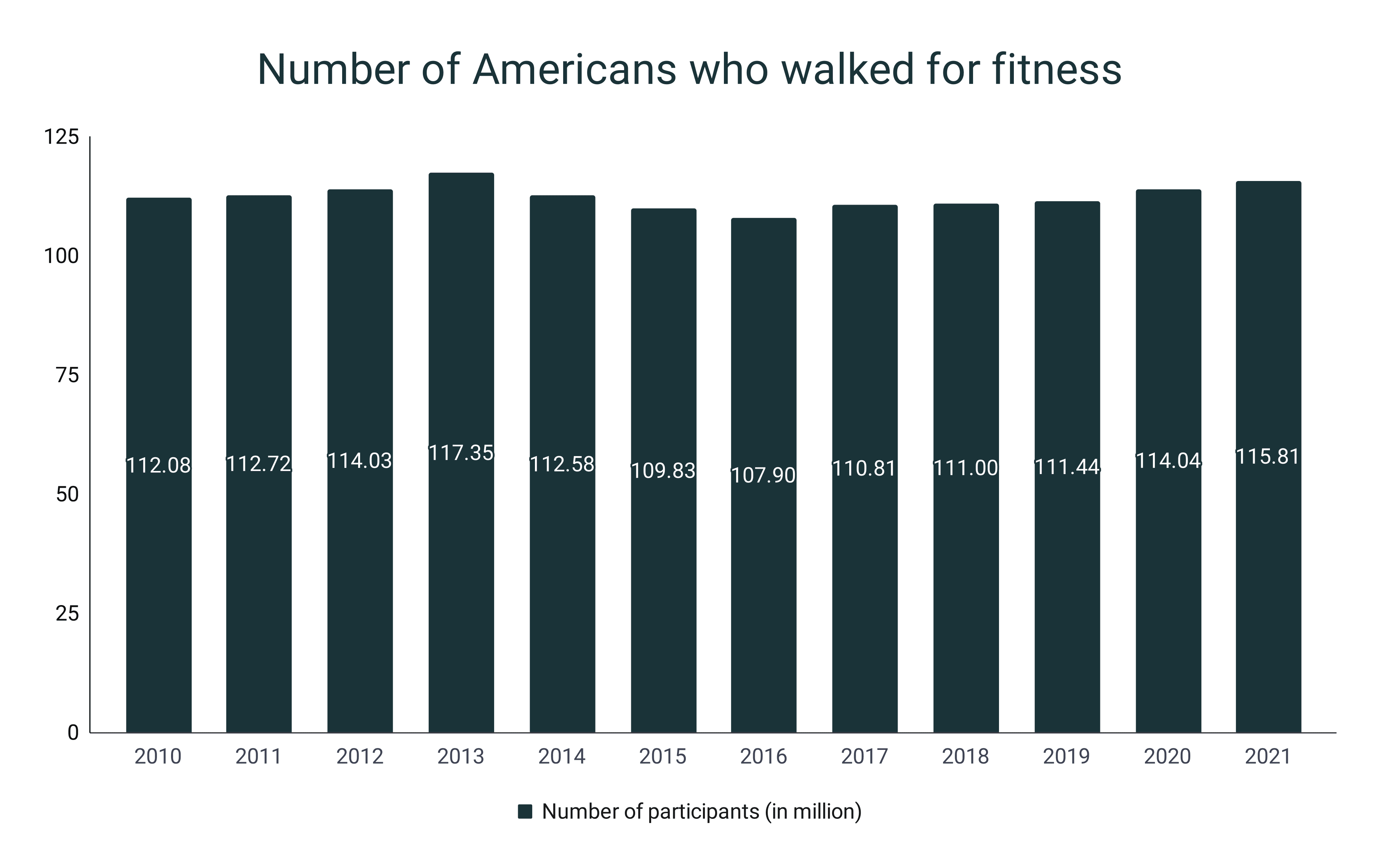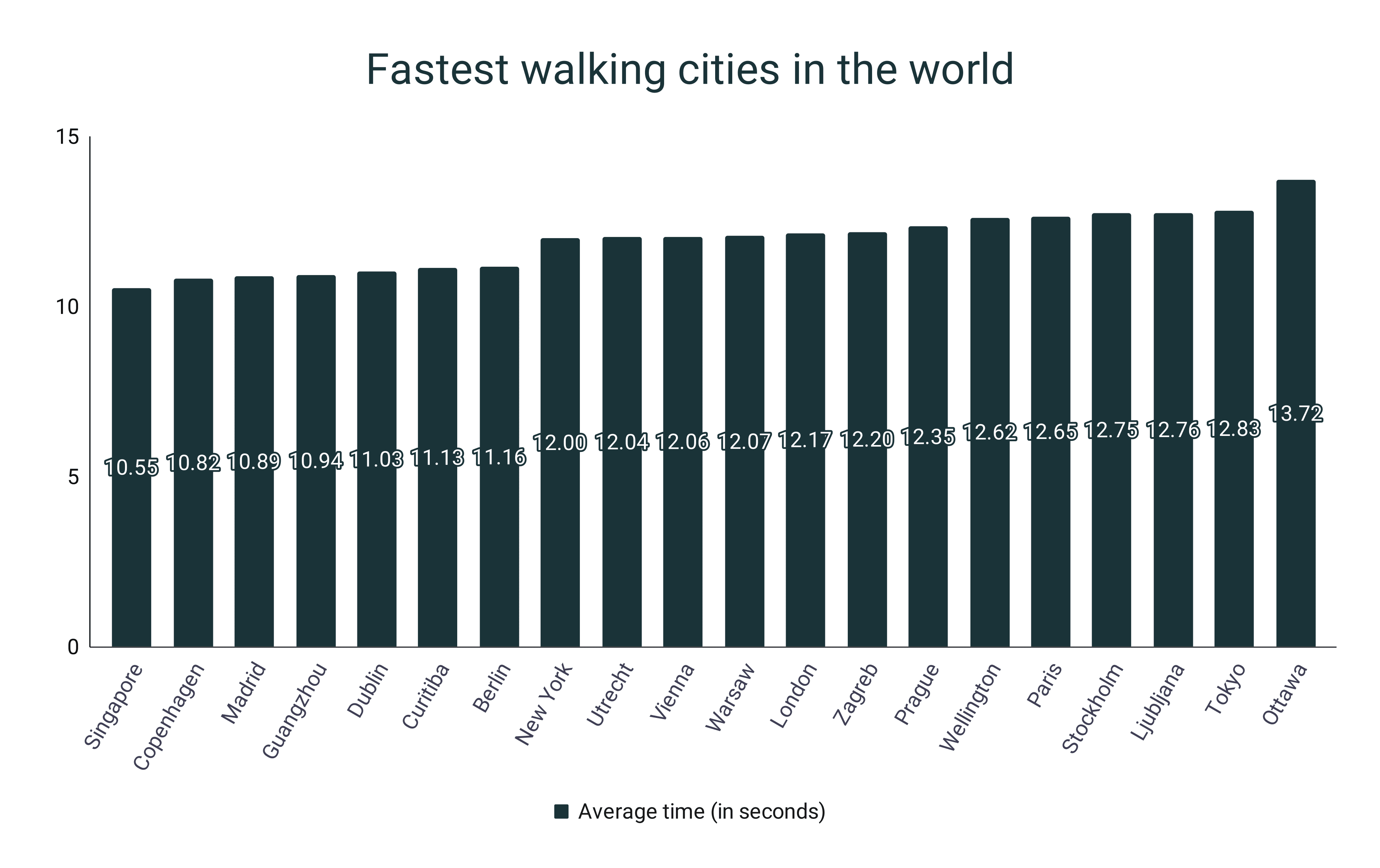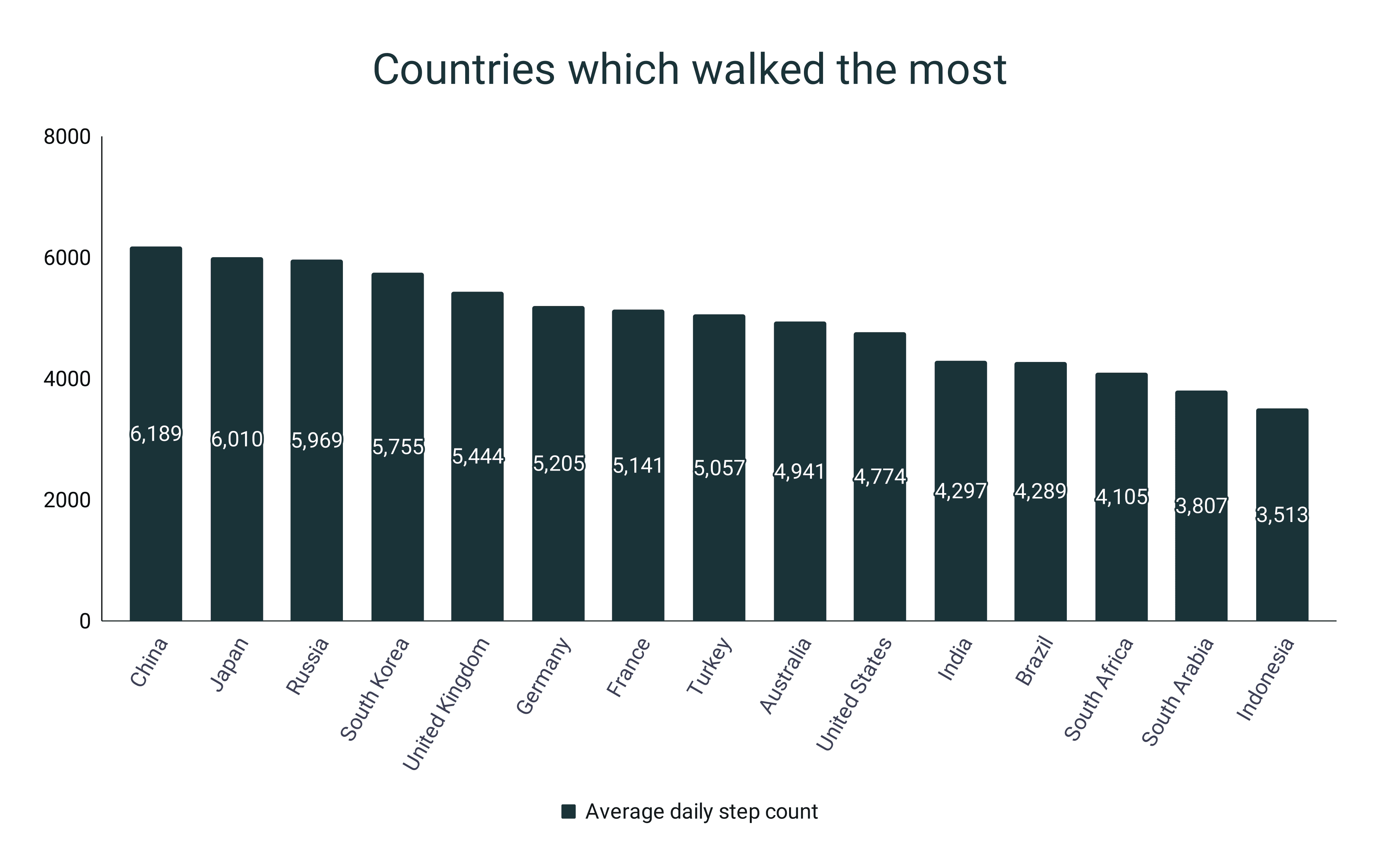Walking Statistics
Walking shoes statistics
- The walking shoe market size in the US was valued at $4.8B in 2022.
- In 2021, walking shoes also generated a $4.8B market size.
- The walking shoe market size jumped by 4.7% in 2021 compared to 2020.
- From 2022 to 2030, the US market size of walking shoes is expected to increase at a compound annual growth rate or CAGR of 4.45%.
- Accordingly, in 2030, this market size is predicted to grow to $6.798B.
|
Year |
Market Size (in $ billions) |
|
2020 |
4.58 |
|
2021 |
4.8 |
|
2022 |
4.8 |
|
2023 |
5.01 |
|
2024 |
5.24 |
|
2024 |
5.47 |
|
2026 |
5.71 |
|
2027 |
5.97 |
|
2028 |
6.23 |
|
2029 |
6.51 |
|
2030 |
6.80 |

How long do walking shoes last?
- Experts recommend replacing walking shoes every 300 to 500 miles.
- If you walk 30 minutes a day, or 3 to 4 hours on average, as part of your workout regimen, you might want to consider changing your shoes every six months.
- Consider changing your shoes every three months if you walk for 60 minutes per day or 7 hours on average each week.
- Walking shoes appreciably lose their ability to support and absorb shock after three to six months.
Calories burned walking vs. running
- You strike the ground with about 1-1.5 times your body weight during walking and 2-3 times your body weight while running.
- Walkers have a 1%-5% chance of encountering an exercise-related injury, while runners face a 20%-70% risk.
- Compared to walking, running burns more than twice as many calories every minute.
- A 160 lb person walking at 3.5 mph for 30 minutes burns around 156 calories. On the other hand, running at 6 mph for half an hour burns around 356 calories.
- Running for a mile on a treadmill burns 33 calories more than walking.
- Calories burned through running resulted in 90% greater weight loss than calories burned through walking.
- Walking is less vigorous than running. Generally, a minute of performing a vigorous activity is equivalent to 2 minutes of moderate-impact activity.
- You always have one foot on the ground when you walk but when you run, two feet are in the air.
- The metabolic equivalent of task (MET) is the energy consumed while sitting quietly. With that said, walking expends 3-6 METs while running uses 6-23 METs.
- Walking for 15 minutes is as beneficial as running for 5 minutes.
How to burn more calories walking?
- Swinging your arms and bending them at a 90-degree angle while walking improves calorie burning by 5% to 10%.
- Jacking up the incline of the treadmill by 5% to 10% while walking helps in burning more calories.
- Utilise a walking pole to burn 30% more calories.
- Walking poles also lessen the strain on knees and hips by 30%
- Walking with a walking pole makes use of 90% of your muscles.
- The ideal weighted vest to use while walking should be 5% to 10% of your body weight.
Demographics of American walkers
- In 2020, the demographics of walking enthusiasts are dominated by women at 56% as opposed to men at only 44%.
- 14.9% of the total number of walkers in the US is composed of adults from the ages of 25 to 34.
- On the other hand, 16.9% of US walking enthusiasts are 65 and older.
The effect of the pandemic on the walking habit of Americans
- 53% of US citizens are clocking up 1-5 miles more daily than they normally took on before the pandemic started.
- 36% of Americans consistently walk for 1-2 miles every day after the pandemic.
- While 21% made 3-4 miles of strolling per day a part of their routine.
- 93% of Americans declared that they would “very likely” or “somewhat likely” keep up with their walking habits even after the pandemic.
American’s purpose in walking
- 57% of Americans walk to relieve their stress.
- While 67% found walking to help them think more clearly and allow them to contemplate their lives.
- The social and personal advantages of walking, such as meeting with friends and family, are used and considered effective by 28% of Americans.
- One-third of US citizens utilise walking to take a breather from work.
- On the other hand, half the Americans make use of walking to maximise time without phones and gadgets.
How many people walk for fitness?
- 6 out of 10 people walk at least once a week, making it the most popular type of exercise.
- In 2021, around 115.8 million US citizens from the ages of 6 and above engaged in walking to boost their health.
- 2021 displayed a 1.6% growth from 2020, with 114 million participants.
- Consequently, the number of walkers in 2020 exhibited a 2.3% hike from the record in 2019, which was approximately 111.4 million people.
- In 2018, 111 million people walked for fitness.
|
Year |
Number of Americans Who Walk for Fitness (in millions) |
|
2010 |
112.08 |
|
2011 |
112.72 |
|
2012 |
114.03 |
|
2013 |
117.35 |
|
2014 |
112.58 |
|
2015 |
109.83 |
|
2016 |
107.90 |
|
2017 |
110.81 |
|
2018 |
111.00 |
|
2019 |
111.44 |
|
2020 |
114.04 |
|
2021 |
115.81 |

How often do people walk?
- 38.5% of people walk at least 5 times a week.
- 16.8% of pedestrians walk 3 to 4 times a week.
- 13.2% admitted they walk 1 to 2 times per week.
- 4.4% of people take an on-foot journey more than once a month.
- 4.3% of people walk less than monthly.
- 22.8% stated that they never travel by foot.
Economic impacts of walking
- Having pedestrian spaces improved commerce in NYC by 172%.
- In London, walker-friendly streets boosted people’s time spent in restaurants and other establishments by 216%.
- Cities that are accessible to walkers have 5 times fewer vacant shops.
- For every $1 million spent on pedestrian projects, 11 jobs are generated.
Walking accidents
- In a year, 270,000 walkers become victims of road accidents.
- 17% of these deaths involved vehicles, while 82% took place in urban areas.
- 4 out of 10 US citizens observed a distracted walking incident.
- 26% of Americans admitted they have personally encountered a walking incident.
- 69% of incidents from 2004 to 2010 were caused by talking on the phone while walking.
- 9% of accidents were because of texting.
- Pedestrians who texted while crossing the intersections in Seattle took 18% longer to travel across and are 4x more likely to exhibit an “unsafe crossing behaviour.”
Which cities walk the fastest?
35 men and women in different cities are timed to walk a 60-foot pathway without any kind of obstructions for them to walk at an optimal speed.
- Singapore ranked first with an average interval of 10.55 seconds.
- The secondary city is Copenhagen, with a 10.82-second record.
- Following this is Madrid which only took 10.89 seconds on average.
- Guangzhou is next in line with a time record of 10.94 seconds.
- With an average duration of 11.03, Dublin made it to the fifth spot.
- The sixth fastest city is Curitiba in Brazil, which recorded 11.13 seconds.
- New York is in eighth place, logging 12 seconds.
- Clocking in 12.17 seconds is London, which made it to the top 12.
|
Rank |
City and Country |
Average time (in seconds) |
|
1 |
Singapore (Singapore) |
10.55 |
|
2 |
Copenhagen (Denmark) |
10.82 |
|
3 |
Madrid (Spain) |
10.89 |
|
4 |
Guangzhou (China) |
10.94 |
|
5 |
Dublin (Ireland) |
11.03 |
|
6 |
Curitiba (Brazil) |
11.13 |
|
7 |
Berlin (Germany) |
11.16 |
|
8 |
New York (USA) |
12.00 |
|
9 |
Utrecht (Netherlands) |
12.04 |
|
10 |
Vienna (Austria) |
12.06 |
|
11 |
Warsaw (Poland) |
12.07 |
|
12 |
London (United Kingdom) |
12.17 |
|
13 |
Zagreb (Croatia) |
12.20 |
|
14 |
Prague (Czech Republic) |
12.35 |
|
15 |
Wellington (New Zealand) |
12.62 |
|
16 |
Paris (France) |
12.65 |
|
17 |
Stockholm (Sweden) |
12.75 |
|
18 |
Ljubljana (Slovenia) |
12.76 |
|
19 |
Tokyo (Japan) |
12.83 |
|
20 |
Ottawa (Canada) |
13.72 |

The most walkable states in the US
- New York had the most walkers with 1,263,744 pedestrians taking an average daily step of 5,039.
- California ranked second with 1,086,484 walkers generating a 4,922 average step count every day.
- Third is Washington with 247,170 walkers and an average step count of 4,913.
- Minnesota is fourth in line with 158,253 who travel by foot and expend 4,894 steps a day.
- Next up is Connecticut with a walker population of 104,313 and a step count average of 4,879.
- Oregon got the 6th spot, with a 4,818 daily step count and 162,770 people making up its walker population.
- Indiana made it to the top 10, with 145,134 people who walked to their destinations at an average step count of 4,682.
Factors that would encourage people to walk more
- 36.1% of people agreed that safer walking spaces would make them walk more.
- 35.8% believe that health benefits promoted by walking would encourage them to increase their daily step count.
- Having better infrastructure would push 20.6% of the people to stroll more frequently.
- Walking-distance destinations would motivate 8.5% of people to walk rather than ride to places.
- Better traffic flow is an aspect considered by 5.6% of people to walk more.
- Accessible changing facilities in their destinations would push 2.4% of people to up their step count every day.
- 9.7% considered other reasons apart from the mentioned ones.
- While 13% said that no reason could encourage them to clock up the miles.
How fast do people walk?
- An adult walks at an average speed of 3 mph.
- Brisk or moderate walking is characterised by a speed of 3 mph to 3.5 mph.
- This roughly equates to 100 steps per minute.
- The regular pace of walking is equivalent to taking less than 40 steps per minute.
- 5 mph is considered a fast walking pace.
- Race or competitive walkers can go as quick as 6 mph or faster.
- The average walking speed of males from ages 20 to 29 is 3.04 mph, while the speed of females in the same age bracket is 3 mph.
- Males and females between the ages of 30 to 39 have walking speeds of 3.2 mph and 3.0 mph, respectively.
- 40 to 49-year-old men walk at an average speed of 3.2 mph compared to women who walk at 3.11 mph.
- On average, men in their 50s cover 3.2 miles per hour while women cover 2.93 miles per hour.
- The walking pace of people in their 60s ranges from 2.77 mph to 3.0 mph.
- Older people in the age bracket of 70 to 79 are much slower with an average walking pace of 2.53 mph to 2.82 mph.
- Even slower are men and women in their 80s with a walking speed of 2.17 mph and 2.10 mph.
|
Age |
Gender |
Average walking speed (in mph) |
|
20-29 |
Men |
3.04 |
|
Women |
3.0 |
|
|
30-39 |
Men |
3.2 |
|
Women |
3.0 |
|
|
40-49 |
Men |
3.2 |
|
Women |
3.11 |
|
|
50-59 |
Men |
3.2 |
|
Women |
2.93 |
|
|
60-69 |
Men |
3.0 |
|
Women |
2.77 |
|
|
70-79 |
Men |
2.82 |
|
Women |
2.53 |
|
|
80-89 |
Men |
2.17 |
|
Women |
2.10 |

How many steps should people take per day?
The benefits of walking are enhanced with a greater number of daily steps.
- 5,000 steps per day are considered sedentary.
- Taking 5,000 to 7,499 steps per day is equivalent to a low active level.
- A person walking 7,500 to 9,999 steps per day is somewhat active.
- Pedestrians who fulfil 10,000 steps per day are considered active.
- Walking with 12,500 steps per day and more accounted for high activeness.
- While it is generally recommended to take 10,000 steps per day, most people in America have an average step count of 3,000 to 4,000 only.
- Walking 20,000 steps daily means having outstanding cardiovascular health, along with strong legs.
- Adult males walk 5,340 steps on average while adult females walk 4,912 steps.
- Adolescents in the age bracket of 12 to 19 have an average daily step count of 8,000 to 9,000.
- Children between the ages of 6 to 11 take significantly more steps, with boys walking 12,000 to 16,000 steps and girls walking 10,000 to 13,000 steps.
Occupations that walk the most
- Jobs that necessitate the most walking are waiters with 23,000 steps a day.
- They are followed by nurses with 16,000 steps a day.
- Retail workers come third with almost 15,000 steps a day.
- Next in line are farmers with 14,000 average daily step counts.
- Stay-at-home parents are also top walkers close to farmers with almost 14,000 steps per day.
- Following them are teachers who reach up to 13,000 steps a day.
- Dog owners walk 4x as much as non-dog owners do.
Walking fun facts
- The longest uninterrupted walk recorded lasted 2,425 days and covered 19,019 miles from the southernmost border of South America to the farthest north of Alaska.
- The average daily step count of everyone in the world is 4.961.
- Approximately 200 body muscles are used when walking.
- Using pedometers enhanced people’s daily step count by 2,000, which is roughly a mile.
- An average person walks approximately 110,000 miles or a total of five journeys around the globe.
- The most ideal number of steps for children and adolescents at the ages 5 to 19 is approximately 12,000 daily.
- On the other hand, 10,000 steps might be excessive for older adults, including those battling with chronic illnesses.
- You will walk 65,000 miles in your lifetime, which is 3x the circumference of the Earth.
- Removing 1 car can fit 20 pedestrians on the streets.
Where do most people walk?
- According to the United States Department of Transportation, 46% of trips to school or church, 40% to shops, 35% to work, and 60% to leisurely activities are within 1 mile.
- On the other hand, 1% of trips to school or church, 1% to shops, 1% to work, and 5% to leisure activities are within 3 to 4 miles.
- In Africa, over 75% of everyday trips are walked.
- In Europe, 12%-30% of daily trips are walked.
Walking statistics by country
- The country that walks the most with an average step count of 6,189 daily is China.
- Japan is the second most active country, taking 6,010 steps a day.
- It is followed by Russia with an average steps of 5,969 every day.
- South Korea is next in line with a 5,755 daily step count.
- The fifth country considered to walk the most steps every day is the United Kingdom with 5,444 steps.
- The 9th and 10th spots are occupied by Australia and the United States, with 4,941 and 4,774 daily step counts.
|
Country |
Average Daily Step Count |
|
China |
6,189 |
|
Japan |
6,010 |
|
Russia |
5,969 |
|
South Korea |
5,755 |
|
United Kingdom |
5,444 |
|
Germany |
5,205 |
|
France |
5,141 |
|
Turkey |
5,057 |
|
Australia |
4,941 |
|
United States |
4,774 |
|
India |
4,297 |
|
Brazil |
4,289 |
|
South Africa |
4,105 |
|
South Arabia |
3,807 |
|
Indonesia |
3,513 |

